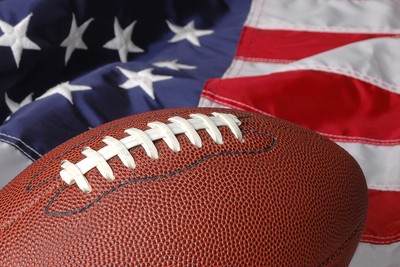 You can call it the ‘Game of Games’, the ‘Greatest Show on Earth’ or ay other snappy moniker….just don’t call it the Super Bowl.
You can call it the ‘Game of Games’, the ‘Greatest Show on Earth’ or ay other snappy moniker….just don’t call it the Super Bowl.
It’s the most-watched sporting event in North America and second only to the World Cup final globally, and yet you’re not allowed to utter the words ‘Super Bowl’ unless you’re an official sponsor or commercial partner of the NFL – just one of the strange quirks of this most iconic of occasions.
But there’s no such limitation on the written word, so we can take a deep dive into the history of the game that must not be named – okay, let’s just get it over with: here’s a look at the amazing evolution of the Super Bowl, from its origins in the NFL vs AFL wars to today’s glittering showpiece watched by an estimated 120 million people.
When Was Super Bowl I?
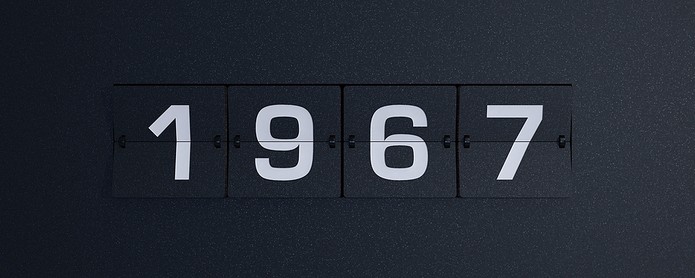
Every great story has a beginning, and for the Super Bowl that came way back in 1966 – the same year that England as enjoying a sporting fairytale of its own with the World Cup final at Wembley Stadium.
For decades, the NFL had largely enjoyed a monopoly as the only American football organisation worth its salt, creating a platform for professionalism that would allow the players to be paid for their endeavours.
But in 1960, a shiny new upstart came along: the American Football League (AFL). The NFL had seen off pretenders to its throne before, but the AFL had something different: it took players that had been rejected by NFL teams and made them better, creating a competition in which the standard was on a par with the more established league.
The NFL’s grip on American football was eroded….and they didn’t like it.
What do many big businesses do when they have a pesky new rival emerge on the scene? They try to buy them out, but with the AFL growing so strong the only measure that the NFL had was to call a truce – a merger agreement was drafted, despite the bad blood that existed between the two entities.
Both sides of the divide put pen to paper in 1966, and of the various terms and conditions it was agreed that an AFL vs NFL championship game would be played each season to determine the best team in American football.
The contest wouldn’t gain the Super Bowl branding until later, so it has only become to be known as Super Bowl I retrospectively. Instead, the rather less-catchy AFL-NFL World Championship Game took place in January 1967.
Who Won the First Super Bowl?
It was the NFL that grabbed the early bragging rights, as their representatives Green Bay Packers trounced the AFL’s Kansas City Chiefs 35-10 at Super Bowl I in Los Angeles.
AFL–NFL World Championship Game (Super Bowl I)
| Quarter | Green Bay Packers | Kansas City Chiefs |
|---|---|---|
| 1st | 7 | 0 |
| 2nd | 7 | 10 |
| 3rd | 14 | 0 |
| 4th | 7 | 0 |
| Final | 35 | 10 |
The game proved so seismic that Vince Lombardi, the coach of the Packers who also led the team to glory at Super Bowl II, would be immortalised forever – to this day, the prize handed to the franchise that wins the Super Bowl is called the Vince Lombardi Trophy.
TV companies were also dragged into American football’s civil war, with NBC broadcasting AFL games and CBS securing the rights to the NFL. When the idea of Super Bowl I was floated, they couldn’t agree on who would get to show the game – instead, they were forced to broadcast simultaneously, combining to show the action to an audience of around 51 million, which was around 25% of the entire population of the United States.
The half-time show, which has become iconic in modern times, was a rather more low-key affair at Super Bowl I. The entertainment was provided by Al Hirt, a famous trumpeter of the age, who was joined on the field by a marching band from the University of Arizona.
There was also a symbolic release of doves – considered to be something of a peace treaty between the NFL and AFL, plus actual working jetpacks, in what was a rather bizarre spectacle to behold.
Our very first Super Bowl was played 55 years ago today at the LA Coliseum.
The jetpack halftime show was an absolute spectacle 😂👨🚀. (Jan. 15, 1967) pic.twitter.com/tWtihICafu
— NFL (@NFL) January 15, 2022
Why Is It Called the Super Bowl?
It’s amazing to think that one of the most recognisable names in world sport came about due to a mispronunciation of a children’s toy.
Lamar Hunt was a businessman and entrepreneur who loved American football – so much so that he tried to buy at least two NFL teams, without success.
Frustrated at being unable to break into the sport, Hunt created his own football competition: the American Football League. The rest, as they say, is history.
When it was agreed that an AFL vs NFL season-ending game would be played, Hunt had semi-seriously suggested that the contest be called ‘Super Ball’, the name of a toy that his kids were playing with at the time. Somewhere along the line, through mispronunciations and opaque communication, Super Ball became Super Bowl.
NFL representatives did not share Hunt’s enthusiasm for the moniker, but it seemed to capture the imagination of players, coaches and fans of the sport, who began calling the championship game the Super Bowl on their own terms.
Before long, the name became so ubiquitous that it was agreed that the third AFL vs NFL game in 1969 would officially be dubbed Super Bowl III.
Why Does the Super Bowl Use Roman Numerals?

So why weren’t those early incarnations called Super Bowl 1, 2, 3 etc?
The answer is slightly contrived. The regular NFL season takes place in one year, with the Super Bowl occurring the year after. For example, the 2023 campaign saw the regular season games played that year, but the play-offs – which determine the two Super Bowl competitors – took place in January, with the Super Bowl itself following in February.
So, by that logic, whoever wins the Super Bowl in 2024 is, technically, the champion of 2023 instead.
Confused? So was everybody else, so they did away with the dates and numbers and introduced roman numerals instead. The first official edition to use them, rather than them being added retrospectively, was Super Bowl V in 1971.
It’s a system that remains in place to this day, albeit with a few exceptions. In 2016, the Super Bowl enjoyed its fiftieth anniversary – a game which, in theory, should have been called Super Bowl L.
But NFL chiefs didn’t like the way the branding looked, so to celebrate the historic occasion they switched to a standard numeric system and labelled the game Super Bowl 50 instead.
How Many People Watch the Super Bowl?
Although enjoying its primary popularity in North and Central America, the Super Bowl still commands an extraordinary audience around the globe.
Nielsen, a company that specialises in recording TV viewing figures, found that 113 million people watched Super Bowl LVII in 2023 – the second most-watched edition in history.
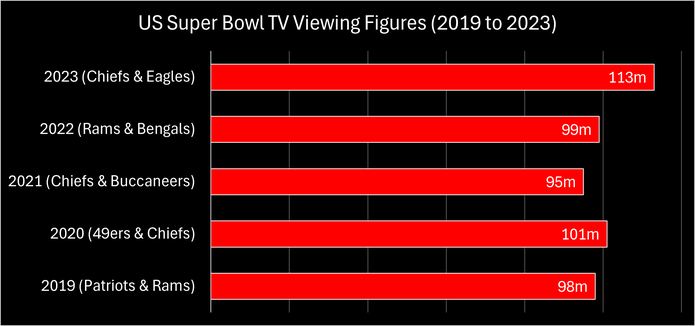
Their findings also concluded that 77% of all households in the USA watched some or all of the Big Game.
It’s interesting to compare that to the football World Cup, with the 2022 final watched by 1.5 billion people worldwide. In the UK, that figure was just shy of 20 million – or around 30% of the total population.
And when England has some skin in a big game – as they did in the Euro 2020 final against Italy, the TV viewing figure reached 31 million; still less than 50% of the population.
Although the World Cup is undoubtedly the most watched sporting event on the planet, the audience figures for the Super Bowl are incredible – in an age where there are so many distractions, compared to a bygone era when gathering the family around the TV was an everyday occurrence, the TV viewing figures are actually increasing.
The chart below tracks Super Bowl viewership, in millions of people, for the past five decades:
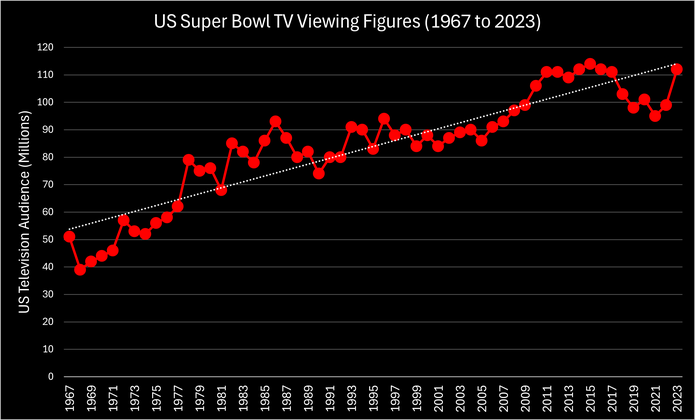
The same linear progression is not shared by global viewing figures for the football World Cup, with the audience for the final varying wildly – perhaps as a result of the identity of the two teams and their relative appeal.
But that’s not the case for the Super Bowl, with the TV audience increasing regardless of who is playing in the Big Game – so few Americans have ‘skin in the game’ as supporters of the two teams involved, and yet they tune in in their droves regardless.
Do Super Bowl Half-Time Performers Get Paid?

At a football game in the UK, the half-time entertainment generally revolved around retreating to the concourse for a pie and a pint or a box of chips and a cup of tea – perhaps with some kind of prize draw or on-pitch competition thrown in for good measure.
But one of the great lures of the Super Bowl for the average TV viewer, particularly those who don’t normally watch American football, is the iconic half-time show – a tradition which dates back more than 50 years to the days of peace symbols and jetpacks.
During the early years of the Super Bowl, it became customary for a traditional marching band to perform a few numbers at half-time. But in the early 1970s, organisers decided to sprinkle some stardust on proceedings by inviting noteworthy singers and performers of the time to put on a show – Ella Fitzgerald and Andy Williams were amongst those early contributors.
But the emphasis remained on jazz, easy listening and song-and-dance routines for many years – until New Kids on the Block agreed to perform at half-time during Super Bowl XXV at the Tampa Stadium in 1991.
This was trailblazing, as the half-time show began to move away from song-and-dance towards letting artists perform their own material, rather than carefully-curated cover versions – by 1993, Michael Jackson was at the Pasadena Rose Bowl belting out Billie Jean, Black or White and other hits, as he became the first singer to be the sole act on the pitch at half-time.
The worlds of film and sport collided in the nineties when the 1995 show saw a sort of Indiana Jones theme unravel, before 1997 saw the cast of the Blues Brother perform alongside the rather eclectic pairing of James Brown and ZZ Top.
By the new millennium, the biggest musical acts on the planet were taking to the half-time stage, causing controversy (Janet Jackson’s nipple-gate), hilarity (Katy Perry’s free dancing shark) and a sort of what-did-I-just-see joviality (Lady Gaga flying around the NRG Stadium in Houston on a zipline).
Given that the acts that perform the half-time show DON’T get paid, you might be wondering why bother – what’s in it for them!? Well, in the case of Rihanna’s performance in 2023, a record 121 million viewers tuned in for her outing; not a bad number when you’ve got a back catalogue of songs to sell, plus clothing lines, beauty products, fragrances and more besides.
How Much Does It Cost to Advertise at the Super Bowl?
The Super Bowl is also famous for its commercial breaks, with many big name businesses producing one-off skits to promote their wares to the mammoth TV audience.
And they need to be big name, because the cost of buying a 30-second slot during the Super Bowl ads has skyrocketed – way beyond the rate of inflation.
At Super Bowl I in 1967, the cost of advertising space was $42,000 per 30 seconds – using an inflation calculator, we learn that this becomes $383,000 today (or around £303,000).
Fast forward to the modern era, and here’s how the cost of advertising space at the Super Bowl has sky-rocketed:
Super Bowl Advertising Cost
| Year | Cost | Inflation Adjustment |
|---|---|---|
| 2003 | $2.2 million | $3.7 million |
| 2013 | $3.8 million | $4.9 million |
| 2023 | $7 million | – |
So, even when accounting for inflation, the cost of buying ad space during the Super Bowl commercials has pretty much doubled in the space of 20 years – the $7 million charged in 2023, and again in 2024, the highest fee ever requested.
Is it worth it? Well, there aren’t many TV shows that get 110 million viewers in the United States alone, plus an extra 50 million or so worldwide. And it’s also the notoriety and brand awareness of an advert that catches fire on social media during Super Bowl Sunday that aids a firm’s efforts – Pringles, for example, have teamed up with Hollywood ace Chris Pratt for their 2024 outing….presumably he doesn’t come cheap, either.
Is the Super Bowl Really Sport’s ‘Big Game’?
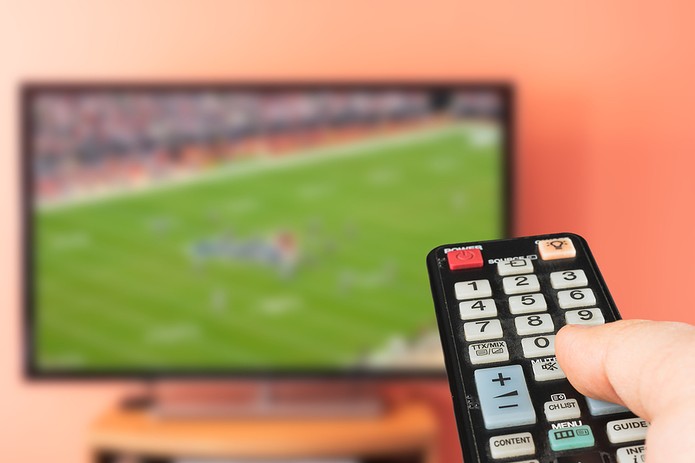
Globally, the Super Bowl can’t lay a glove on the football World Cup in terms of interest, and even events like the Olympic Games outstrip the NFL championship contest for TV spectatorship.
But there’s just something about a sporting event witnessed by 77% of households in a single country – not to mention a huge nation like the United States – that reveals why it’s the game that makes the whole country stand still. It’s unthinkable that an FA Cup final or a Wimbledon final would be watched by 77% of households in the UK.
Factor in the commercial scale of the Super Bowl – for context, British firms paid £400,000 for an on TV during the World Cup final in 2022, and it becomes clear that, in some ways, this really is the most significant sporting event of the year….for those involved, those with a passing interest watching on from home and big corporations, too.